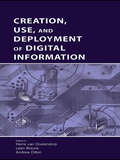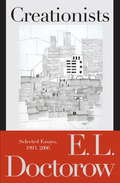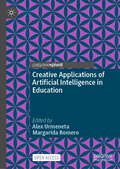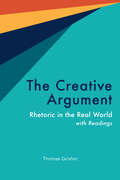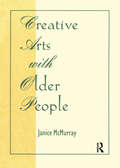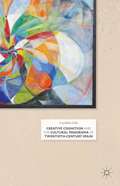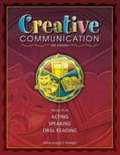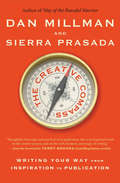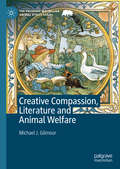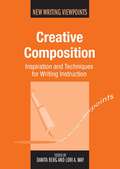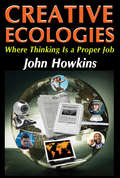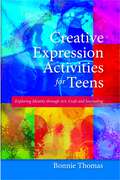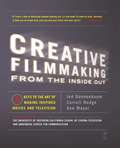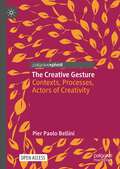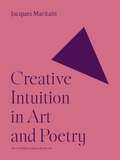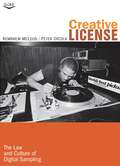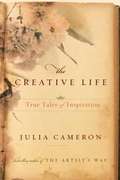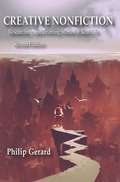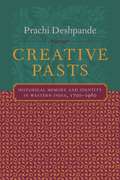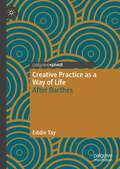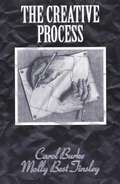- Table View
- List View
Creation, Use, and Deployment of Digital Information
by Herre Van Oostendorp Leen Breure Andrew DillonThe aim of this book is to present results of scientific research on how digital information should be designed and how artifacts or systems containing digital content should maximize usability, and to explain how context can influence the nature and effectiveness of digital communication. Using a philosophical, cognitive, and technical standpoint, the book covers the issue of what digital information actually is. The text also presents research outcomes from the perspective of research in information science--broadly construed--a term now used to cover a range of theoretical and practical approaches.Creation, Use, and Deployment of Digital Information is broken down into three parts:*Part I presents information on how electronic documents can be realized--the complexities, alternatives, functions, and restrictions are treated here.*Part II discusses how human beings process information and how technical solutions can satisfy human restrictions.*Part III treats the context in which digital information processing and deployment takes place.The book has much to offer to academics in many disciplines, including science, the arts, psychology, education, and the information and computing sciences.
Creationists
by E. L. DoctorowE. L. Doctorow is acclaimed internationally for such novels as Ragtime, Billy Bathgate, and The March. Now here are Doctorow's rich, revelatory essays on the nature of imaginative thought. In Creationists, Doctorow considers creativity in its many forms: from the literary (Melville and Mark Twain) to the comic (Harpo Marx) to the cosmic (Genesis and Einstein). As he wrestles with the subjects that have teased and fired his own imagination, Doctorow affirms the idea that "we know by what we create."Just what is Melville doing in Moby-Dick? And how did The Adventures of Tom Sawyer impel Mark Twain to radically rewrite what we know as Huckleberry Finn? Can we ever trust what novelists say about their own work? How could Franz Kafka have written a book called Amerika without ever leaving Europe? In posing such questions, Doctorow grapples with literary creation not as a critic or as a scholar-but as one working writer frankly contemplating the work of another. It's a perspective that affords him both protean grace and profound insight. Among the essays collected here are Doctorow's musings on the very different Spanish Civil War novels of Ernest Hemingway and André Malraux; a candid assessment of Edgar Allan Poe as our "greatest bad writer"; a bracing analysis of the story of Genesis in which God figures as the most complex and riveting character. Whether he is considering how Harpo Marx opened our eyes to surrealism, the haunting photos with which the late German writer W. G. Sebald illustrated his texts, or the innovations of such literary icons as Heinrich von Kleist, Harriet Beecher Stowe, and Sinclair Lewis, Doctorow is unfailingly generous, shrewd, attentive, surprising, and precise.In examining the creative works of different times and disciplines, Doctorow also reveals the source and nature of his own artistry. Rich in aphorism and anecdote, steeped in history and psychology, informed by a lifetime of reading and writing, Creationists opens a magnificent window into one of the great creative minds of our time.From the Hardcover edition.
Creative Applications of Artificial Intelligence in Education (Palgrave Studies in Creativity and Culture)
by Alex Urmeneta Margarida RomeroThis open access book explores the synergy between AI and education, highlighting its potential impact on pedagogical practices. It navigates the evolving landscape of AI-powered educational technologies and suggests practical ways to personalise instruction, nurture human-AI co-creativity, and transform the learning experience. Spanning from primary to higher education, this short and engaging volume proposes concrete examples of how educational stakeholders can be empowered in their AI literacy to foster creativity, inspire critical thinking, and promote problem-solving by embracing AI as a tool for expansive learning. Structured in three parts, the book starts developing the creative engagement perspective for learning and teaching to then present practical applications of AI in K-12 and higher education, covering different fields (teacher education, professional education, business education) as well as different types of AI supported tools (games, chatbots, and AI assisted assessment). It also delves into the ethical considerations, policy implications, and the central role educators play in harnessing the power of an AI informed educational experience.
The Creative Argument: Rhetoric in the Real World, with Readings
by Thomas GirshinThe Creative Argument sets itself apart from its competitors by presenting a series of compelling works of literary nonfiction that challenge what students think they know about arguments. Each chapter begins with an engaging argument from a work of nonfiction, followed by an in-depth yet accessible analysis of a key aspect of argumentation. Suitable for both courses in argument and first-year writing, the principles and strategies outlined in the text help students become more creative and critical as rhetoricians, both inside the classroom and out.
Creative Arts With Older People
by Janice McmurrayWith this insightful and intelligent book, professionals can help institutionalized older adults express themselves creatively. One of only a few books on expressive arts for older people, this unique, new volume is ideal for professionals who provide art activities for residents in adult homes and retirement communities.Creative experience can facilitate the expression of ideas and feelings, increase sensory stimulation, improve self-esteem, and improve social relationships. Creative Arts With Older People provides time-tested suggestions to stimulate the creative process among older adults, resulting in numerous physical, psychological, and social benefits. The author, an artist and a social worker, describes dozens of activities that have proven effective in her many years of working with older people--painting, movement, poetry, sculpting, puppetry, dramatic expression, and more. She explains the goals and advantages of each activity, includes a list of materials needed, and details the step-by-step process for conducting each activity.Creative Arts With Older People is a practical and valuable book for activity directors in adult homes and adult health care units, and workers in adult day care centers, adult psychiatric facilities, and senior centers.
Creative Cognition and the Cultural Panorama of Twentieth-Century Spain
by Candelas GalaThis multidisciplinary study focuses on the creative state as the nucleus of the work of numerous poets, artists, and philosophers from twentieth-century Spain. Beginning with cognitive science, Gala explores the mental processes and structures that underline creative thinking, for poets like Jos#65533; Mar#65533;a Hinojosa, Clara Jan#65533;s, and Jorge Guill#65533;n.
Creative Communication: Projects in Acting, Speaking, Oral Reading
by Fran Averett TannerIn this book, the subjects of public speaking, oral communication, and acting are thoroughly reviewed.
The Creative Compass
by Sierra Prasada Dan MillmanA guide should give clear directions and then get out of your way. In this unique collaboration, bestselling author Dan Millman and his daughter Sierra Prasada help to orient you as you advance through five universal stages of creativity: Dream, Draft, Develop, Refine, and Share. Whether you're seeking new goals, the discipline to reach them, a shield against self-doubt and inertia, or practical advice on sorting through feedback and connecting with readers -- you'll find a way forward in this fresh approach to writing and storytelling. Drawing on the coauthors' personal stories about overcoming challenges, as well as sage advice from other writers, artists, and innovators, The Creative Compass will transform both the stories you tell and the stories you live.
Creative Compassion, Literature and Animal Welfare (The Palgrave Macmillan Animal Ethics Series)
by Michael J. GilmourThis book examines animal welfare themes in fiction, and considers how authors of the last two centuries undermine dominative attitudes toward the nonhuman. Appearing alongside the emerging humane movements of the nineteenth century and beyond is a kind of storytelling sympathetic to protectionist efforts well-described as a literature of protest. Compassion-inclined tales like the Dolittle adventures by Hugh Lofting educate readers on a wide range of ethical questions, empathize with the vulnerable, and envision peaceful coexistence with other species. Memorable characters like Black Beauty and Beautiful Joe, Ivan the gorilla and Louis the trumpeter swan, Hazel and Cheeta, Mr. Bultitude and Doctor Rat do not merely amuse. They are voices from the margins who speak with moral urgency to those with ears to hear. This broad survey of ethical themes in animal fiction highlights the unique contributions creative writers make toward animal welfare efforts.
Creative Composition
by Danita Berg Lori A. MayFor decades theorists have opined that the lines between creative writing and composition need to be lifted, yet little has been written about the pedagogical methods that allow a cohesive approach between the disciplines. This book brings together contemporary authors and well-respected creative writing instructors and theorists to explore ways creativity in composition may be encouraged in student writers. The question in this anthology is not 'Can writing be taught?' but 'How can we inspire students to embrace the creative process no matter what they write?' This book offers multiple strategies to merge the best practices of teaching writing, regardless of the genre.
Creative Ecologies: Where Thinking Is a Proper Job (Creative Economy And Innovation Culture Se Ser.)
by Bronislaw Malinowski John HowkinsThe main question of our age is how we live our lives. As we struggle with this question, we face others. How do we handle ideas and knowledge, both our own and those of others? What relationship to ideas do we want? Whose ideas do we want to be surrounded by? Where do we want to think? Most choose, or have the choice made for them, according to what family, colleagues, and friends do and say and what we read about, and a more or less rational calculation of the odds.Modern ecology results from the shift in thinking generated by quantum physics and systems theory, from the old view based on reductionism, mechanics, and fixed quantities to a new view based on holistic systems where qualities are contingent on the observer and on each other. This perception changes how people treat ideas and facts, certainties and uncertainties, and affects both art and science. Worldwide it is part of the process of understanding the current crisis in the environment, and the balance of economy, creativity, and control required in our response.The book's starting point is the growing role that information has played in industrial economies since the 1800s and especially in the last thirty years. It is an attempt to identify ecology of thinking and learning. It is also based on the need to escape from old, industrial ways and become more attuned to how people actually borrow, develop, and share ideas. Throughout the book, Howkins asks questions and offers signposts. He gives no guarantee that creative ecologies will be sustainable, but shows what should be aimed for.
Creative Expression Activities for Teens
by Bonnie ThomasCoping with life's stresses is difficult for everybody, but can be especially challenging for teenagers, who often feel isolated and misunderstood. Creative expression through art, craft, and writing is a natural and effective way of helping young people to explore and communicate personal identity. This book is bursting with art and journal activities, creative challenges, and miniature projects for bedrooms and other personal spaces, all of which help teenagers to understand and express who they are and what is important to them. These fun ideas can be tailored to suit the individual, and require minimal equipment and even less artistic know-how, so can be enjoyed by all. The book concludes with a useful section for counselors and other professionals who work with young people, which explains how these activities can be incorporated into treatment goals. This imaginative and insightful book is a useful resource for all therapists, social workers, and counselors who wish to encourage self-expression in teenagers.
Creative Filmmaking from the Inside Out
by Jed Dannenbaum Carroll Hodge Doe MayerFive keys to creating authentic, distinctive work, whether you are a student, professional or simply love making films on your own For Creative Filmmaking from the Inside Out, three professors at the renowned University of Southern California School of Cinema-Television interviewed fifteen outstanding filmmakers, then distilled their insights into the "Five I's" of creativity. Learn how to: Uncover your unique creative voice (Introspection) Work from real-life observations and experience (Inquiry) Draw on your nonconscious wells of creativity (Intuition) Strengthen your creative collaborations (Interaction) Communicate at the deepest level with your audience (Impact) This comprehensive approach provides practical exercises that will enrich and transform your work, whether you are looking for a story idea, lighting a set, editing a scene or selecting a music cue. The participating filmmakers, who have collectively won or been nominated for 39 Oscars and 27 Emmys, are: Anthony Minghella, writer-director (The English Patient); Kimberly Peirce, writer-director (Boys Don't Cry); John Lasseter, writer-director-producer (Toy Story); John Wells, writer-producer (ER); Hanif Kureishi, writer (My Beautiful Laundrette); Pamela Douglas, writer (Between Mother and Daughter); Renee Tajima-PeÑa, director-producer (My America...or, Honk If You Love Buddha); Ismail Merchant, producer (The Remains of the Day); Jeannine Oppewall, production designer (L.A. Confidential); Conrad L. Hall, cinematographer (American Beauty); Kathy Baker, actor (Picket Fences); Walter Murch, sound designer-editor (Apocalypse Now); Lisa Fruchtman, editor (The Right Stuff); Kate Amend, editor (Into the Arms of Strangers); and James Newton Howard, composer (The Sixth Sense).
The Creative Gesture: Contexts, Processes, Actors of Creativity (Palgrave Studies in Creativity and Culture)
by Pier Paolo BelliniThis open access book offers a concise overview of the theories constructed within the various human sciences around the theme of creativity as a symbolic capacity to link things together: it manifests itself when the individual endowed with a certain type of intelligence encounters cultural and social conditions that enable them to develop that capacity to the maximum, rather than inhibiting it or diverting it to other fields where it is doomed to failure. Even the most intimate of human expressiveness is considered as a result of an active social relationality. Social dimensions of creativity (evaluation, primary socialization, motivation, leadership) and “creative processes” (creative attitude, creative gesture, divergent thinking, problem-solving capacity, interdisciplinary approach, randomness, algorithmic creativity) are also analysed.The book concludes by evaluating the course taken in the light of the relational theory of society: the development of creativity cannot beconceived outside of self-other relations.This book is the result of a translation done with the help of artificial intelligence. The text has subsequently been revised further by a professional copy editor in order to refine the work stylistically.
Creative Intuition in Art and Poetry (The A. W. Mellon Lectures in the Fine Arts #1)
by Jacques MaritainThe classic work on the sublime interplay between the arts and poeticsThis book explores the rich and complex relationship between art and poetry, shedding invaluable light on what makes each art form unique yet wholly interdependent. Jacques Maritain insists on the part played by the intellect as well as the imagination, showing how poetry has its source in the preconceptual activity of the rational mind. As Maritain argues, intellect is not merely logical and conceptual reason. Rather, it carries on an exceedingly more profound and obscure life, one that is revealed to us as we seek to penetrate the hidden recesses of poetic and artistic activity. Incisive and authoritative, this illuminating book is the product of a lifelong reflection on the meaning of artistic expression in all its varied forms.
Creative License: The Law and Culture of Digital Sampling
by Kembrew Mcleod Peter DicolaHow did the Depression-era folk-song collector Alan Lomax end up with a songwriting credit on Jay-Z's song "Takeover"? Why doesn't Clyde Stubblefield, the primary drummer on James Brown recordings from the late 1960s such as "Funky Drummer" and "Cold Sweat," get paid for other musicians' frequent use of the beats he performed on those songs? The music industry's approach to digital sampling--the act of incorporating snippets of existing recordings into new ones--holds the answers. Exploring the complexities and contradictions in how samples are licensed, Kembrew McLeod and Peter DiCola interviewed more than 100 musicians, managers, lawyers, industry professionals, journalists, and scholars. Based on those interviews, Creative License puts digital sampling into historical, cultural, and legal context. It describes hip-hop during its sample-heavy golden age in the 1980s and early 1990s, the lawsuits that shaped U. S. copyright law on sampling, and the labyrinthine licensing process that musicians must now navigate. The authors argue that the current system for licensing samples is inefficient and limits creativity. For instance, by estimating the present-day licensing fees for the Beastie Boys' Paul's Boutique (1989) and Public Enemy's Fear of a Black Planet (1990), two albums from hip-hop's golden age, the authors show that neither album could be released commercially today. Observing that the same dynamics that create problems for remixers now reverberate throughout all culture industries, the authors conclude by examining ideas for reform. Interviewees include David Byrne, Cee Lo Green, George Clinton, De La Soul, DJ Premier, DJ Qbert, Eclectic Method, El-P, Girl Talk, Matmos, Mix Master Mike, Negativland, Public Enemy, RZA, Clyde Stubblefield, T. S. Monk.
The Creative Life: True Tales of Inspiration
by Julia CameronIn The Creative Life , bestselling author of The Artist's Way Julia Cameron parts the curtain on her own life to reveal a world rich with creative possibility. According to Julia Cameron, when we allow our creative spirit to serve as our compass, we discover that the art we have always longed to create is suddenly within our grasp. In this book, she shows readers how to use their creative hearts and minds to cultivate lives that nourish and sustain their art. Through beautifully drawn scenes from her own life, as well as the lives of the many artists around her, Cameron reveals that creativity flourishes during the quiet pauses in our lives—and that it is only when we allow ourselves to slow down and savor life that we uncover ways to depict it sensitively and poetically in our art. .
Creative Lives and Works: Frank Kermode, George Steiner, Gillian Beer and Christopher Ricks
by Alan MacfarlaneCreative Lives and Works: Frank Kermode, George Steiner, Gillian Beer and Christopher Ricks is a collection of interviews conducted by one of England’s leading social anthropologists and historians, Professor Alan Macfarlane. Filmed over a period of 40 years, the four conversations in this volume, are part of a larger set of interviews that cut across various disciplines, from the social sciences, the sciences and to even the performing and visual arts. The current volume on four of England’s foremost literary critics is the first in the series of several such books. Sir Frank Kermode, in James S. Shapiro’s (Professor of English and Comparative Literature at Columbia University who specializes in Shakespeare and the Early Modern period) words is, ‘the best living reader of Shakespeare anywhere, hands down’, George Steiner, in an article in The Guardian is described as a ‘polyglot and polymath’, Gillian Beer is quoted in The Guardian as saying, ‘I am historical remnant of free education: I was carried through by the state’, and W.H. Auden, one of the greatest 20th century poets, described Sir Christopher Ricks as ‘exactly the kind of critic every poet dreams of finding’. Immensely riveting as conversations, this collection takes one into the exciting world of literary criticism. The book will be of enormous value to those interested in Literature, History and Culture Studies. Please note: This title is co-published with Social Science Press, New Delhi. Taylor & Francis does not sell or distribute the Hardback in India, Pakistan, Nepal, Bhutan, Bangladesh and Sri Lanka.
Creative Metaphor, Evaluation, and Emotion in Conversations about Work (Routledge Focus on Applied Linguistics)
by Jeannette Littlemore Sarah Turner Penelope TuckThis book explores the roles played by creative and conventional metaphor in expressing positive and negative evaluation within a particular workplace, drawing on interviews with 31 current and former employees of the British Civil Service. Metaphor is often used to express evaluation but relatively few studies have investigated the ways in which metaphor is used to evaluate personal emotionally charged experiences. The volume explores how metaphor serves a predominantly evaluative function, with creatively used metaphors often more likely than conventional metaphors to perform an evaluative function, particularly when the evaluation is negative or ambiguous. The findings provide a deeper understanding of the relationship between evaluation, creativity, and metaphor. Examples, including military metaphors and family metaphors, show how creativity often comes through subverting the norms of use of a particular metaphor category, or altering the valence from its conventional use. The study elucidates the myriad ways in which people push at the boundaries of linguistic creativity in their efforts to describe the qualitative nature of their experiences. Demonstrating how metaphor can be a powerful tool for the nuanced expression of complex and ambiguous evaluation, this book will appeal to researchers interested in better understanding metaphor, creativity, evaluation, and workplace cultures.
Creative Nonfiction: Researching And Crafting Stories Of Real Life
by Philip GerardWriting creative nonfiction intertwines journalistic truth and literary techniques to tell a story that is clear, accurate, and exploding with meaning. Philip Gerard artfully guides readers through the entire creative nonfiction writing process, going beyond the technical basics to address topics such as ethics, voice, and structural integrity. In response to the genre's evolution, the latest edition includes examples to illustrate how cultural changes have influenced the way writers conduct research, approach writing, and communicate during the production of their projects. Timely, engaging, and poetic, Creative Nonfiction is the practical manual every novice and seasoned writer will want on their bookshelf.
Creative Nonfiction: The Final Issue: The Best of Thirty Years of Creative Nonfiction
by Lee Gutkind and Leslie RubinkowskiThe very best writing from one of America’s most groundbreaking literary magazines. When Creative Nonfiction debuted in 1994, the literary genre it championed was largely the target of skepticism or downright ridicule. But at a time when few editors were interested in the personal essay, the magazine doggedly explored new ideas and fresh modes of expression, and over the next three decades, its contributors pioneered what would come to be known as the “fourth genre.” The thirty-two essays collected here bring together some of the finest work Creative Nonfiction published over its seventy-eight issues. Read Pulitzer Prize-winner Charles Simic’s boyhood remembrances of the bombing of Belgrade, Carolyn Forche’s haunting, lyric catalog of her daily life as she faced down a cancer diagnosis, and John Edgar Wideman’s meditation on the photo of a murdered boy his same age—Emmett Till—and how the image haunted him forever. Here, you'll find work by such luminaries as Adrienne Rich and John McPhee, but also essays from more contemporary voices like Brian Broome, Elizabeth Fortescue, and Anne McGrath. With an introduction by Lee Gutkind, Creative Nonfiction’s founder and editor, this collection captures the evolution of a genre and the amazing work of the little magazine that helped make it all happen.
Creative Pasts: Historical Memory and Identity in Western India, 1700-1960 (Cultures of History)
by Prachi DeshpandeThe "Maratha period" of the seventeenth and eighteenth centuries, when an independent Maratha state successfully resisted the Mughals, is a defining era in the history of the region of Maharashtra in western India. In this book, Prachi Deshpande considers the importance of this period for a variety of political projects including anticolonial/Hindu nationalism and the non-Brahman movement, as well as popular debates throughout the nineteenth and twentieth centuries concerning the meaning of tradition, culture, and the experience of colonialism and modernity. Sampling from a rich body of literary and cultural sources, Deshpande highlights shifts in history writing in early modern and modern India and the deep connections between historical and literary narratives. She traces the reproduction of the Maratha period in various genres and public arenas, its incorporation into regional political symbolism, and its centrality to the making of a modern Marathi regional consciousness. She also shows how historical memory provided a space for Indians to negotiate among their national, religious, and regional identities, pointing to history's deeper potential in shaping politics within thoroughly diverse societies.A truly unique study, Creative Pasts examines the practices of historiography and popular memory within a particular colonial context, and illuminates the impact of colonialism on colonized societies and cultures. Furthermore, it shows how modern history and historical memory are jointly created through the interplay of cultural activities, power structures, and political rhetoric.
Creative Power: The Nature And Nurture Of Children's Writing
by Ronald L. CramerThis accessible book examines the nature of children's writing, and helps teachers discover how to best nurture in children's creative potential. A thorough explanation of the practices and strategies needed to understand young writers and their writing, the book provides a wealth of information and ideas about the language, interests, and creative capabilities of today's children. Strong pedagogy offers explicit, practical examples with direct application to instruction. Each chapter begins with a brief vignette that captures the drama and excitement of becoming a writer. Boxed features summarize the best approaches to putting instructional concepts and strategies into practice. For Elementary English Teachers.
Creative Practice as a Way of Life: After Barthes (Palgrave Studies in Creativity and Culture)
by Eddie TayThis book combines autoethnographic reflections, poetry, and photography with the aim to bridge the gap between creative practice and scholarly research. Drawing on an innovative combination of different forms of knowledge, creative writing and street photographs are presented as means to reflect on the development of knowledge and self-knowledge through a thought-provoking dialogue with Roland Barthes’ post-structuralist work. What does it mean to be a creative practitioner in a world traversed by values of capitalism and artificial intelligence? What does it mean to teach creative practices in such an environment?The urban landscape of Singapore, with the Jewel Changi mall, the Universal Studios, and Little India in the background, is the stage where the capitalist demands of modern city life grapple with the solitary act of writing poetry and taking photographs through the personal experience of the author. Capitalist realism and depression realism entwine with Barthes' notion of vita nova in a mesmerizing phantasmagoria that drags the reader to the bowels and secret pleasures of the creative process.
The Creative Process
by Carol Burke Molly Best TinsleyA process approach to creative writing, emphasizing open-ended exploratory writing through carefully focused exercises and journal-writing activities. Focuses on writing poems, stories, and essays, with samples by professionals and students that illustrate techniques.
